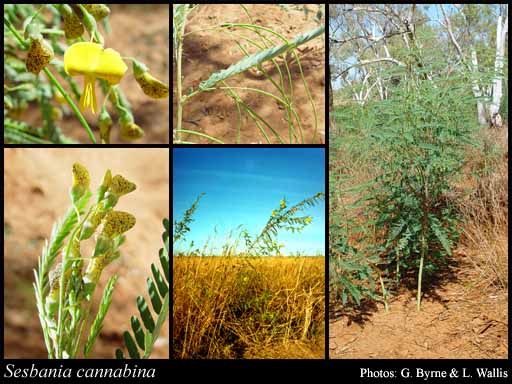- Reference
- Syn.Pl. 2:316 (1807)
- Conservation Code
- Not threatened
- Naturalised Status
- Native to Western Australia
- Name Status
- Current
Erect, spindly annual, herb or shrub, 0.5-3 m high. Fl. yellow-orange, Feb to Aug or Oct. Sandy, clay & loamy soils. Creek & river beds, areas subjected to seasonal water-logging.







Scientific Description
Genus Sesbania. Form prostrate,spreading or scrambling. Habit shrub, spindly shrub (broom-like). Stems Indumentum hairy, Pustules or glands absent, Striation (stems ribbed) striate, Cross section winged, Spiny on any part of plant not spiny. Leaves or phylloclades Presence clearly present, Position alternate, Leaves compound, Leaves or phylloclade continuous with stem continuous with stem, Cross section of leaf or leaflet flat with flat margins, Margins of leaf or leaflet entire, Tuberculate tubercles absent, Pustules or glands absent. Length Leaf length 65-290. Width (entire leaves only) Leaf width NaN (?). Scale leaves length mm long NaN (?). Leaflets Number more than three, Number of leaflets (if more than three) 17-41, Arrangement pinnately arranged. Terminal leaflet Presence present, Stalk stalked. Indumentum Presence glabrous. Stipules Presence present but early deciduous ( only visible on youngest leaves ), Glands without glands, Ribs ribless. Length Stipule length 3.5-5. Bracteoles Presence present but early deciduous, Indumentum hairy (?) or glabrous (?), Striation striate (?) or not striate (?). Length Bracteole length NaN (?). Pedicel Presence present, Indumentum hairy. Length Pedicel length 8. Calyx Pustules or glands absent, Ribs ribless, Enlarged in fruit not accrescent. Length Calyx length 5-10. Indumentum Presence glabrous. Corolla Colour patterning multicoloured, Colour (when multicoloured - choose one colour) yellow or orange, Colour (when multicoloured - choose a second colour) yellow or orange, Petal claws ( the narrow base of the petals present. Length Corolla length 18-20. Indumentum Presence absent. Standard Indumentum glabrous, Auricles not auriculate. Length Standard length 15-16. Wings Auricles not auriculate. Length Wing length 14-15. Keel Auricles not auriculate, Indumentum glabrous, Beak not beaked. Length Keel length 15-16. Stamens Number ten. Anthers anther length 1.3-2, Position at two different levels (filaments alternately long and short). Filaments Fusion united in an open sheath with one free stamen. Length Filament length 10-15. Ovary Placement stipitate. Indumentum Presence glabrous. Style Indumentum glabrous, Bearded ( with a tuft of hairs at apex ) not bearded, Apex terete. Length Style length 17-19. Fruit Type dehiscent (a pod or follicle), Constriction not constricted between the seeds, Compression flat or compressed, Placement stipitate, Beak beaked. Length Fruit length 140-150. Width Fruit width 4-5. Indumentum Presence glabrous. Flowering time February, March, April, May, June, July, August or October. Distribution Botanical Province Northern, Eremaean or South-West, IBRA Bioregion Great Sandy Desert, Pilbara, Carnarvon, Gascoyne, Little Sandy Desert, Northern Kimberley, Victoria Bonaparte, Central Kimberley, Ord-Victorian-Plain, Tanami, Dampierland or Geraldton Sandplains.
Distribution
- IBRA Regions
- Carnarvon, Central Kimberley, Dampierland, Darwin Coastal, Gascoyne, Geraldton Sandplains, Great Sandy Desert, Little Sandy Desert, Northern Kimberley, Ord Victoria Plain, Pilbara, Tanami, Victoria Bonaparte.
- IBRA Subregions
- Ashburton, Augustus, Berkeley, Cape Range, Chichester, Fitzroy Trough, Fortescue, Hamersley, Hart, Keep, Lesueur Sandplain, McLarty, Mitchell, Mount Eliza, Pentecost, Pindanland, Purnululu, Roebourne, Rudall, Tanami Desert, Wooramel.
- IMCRA Regions
- Canning, Kimberley, North West Shelf, Pilbara (nearshore).
- Local Government Areas (LGAs)
- Ashburton, Broome, Carnarvon, Coorow, Derby-West Kimberley, East Pilbara, Exmouth, Halls Creek, Karratha, Port Hedland, Upper Gascoyne, Wyndham-East Kimberley.